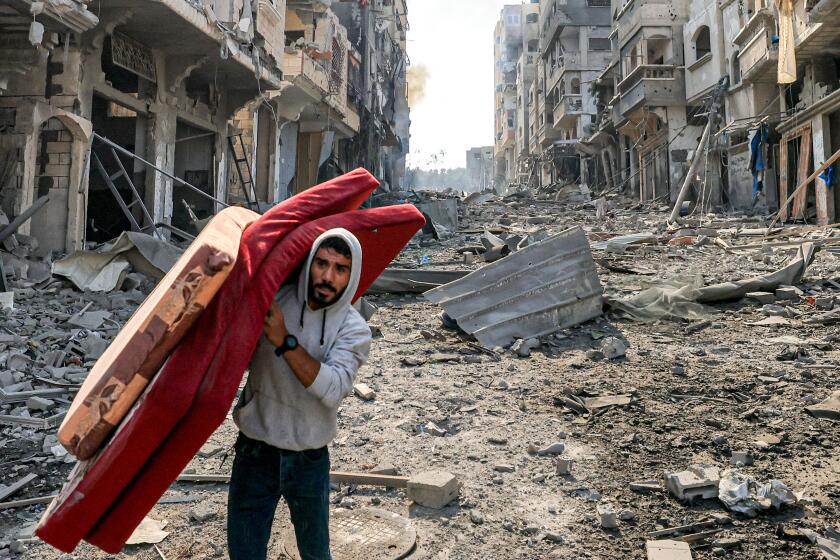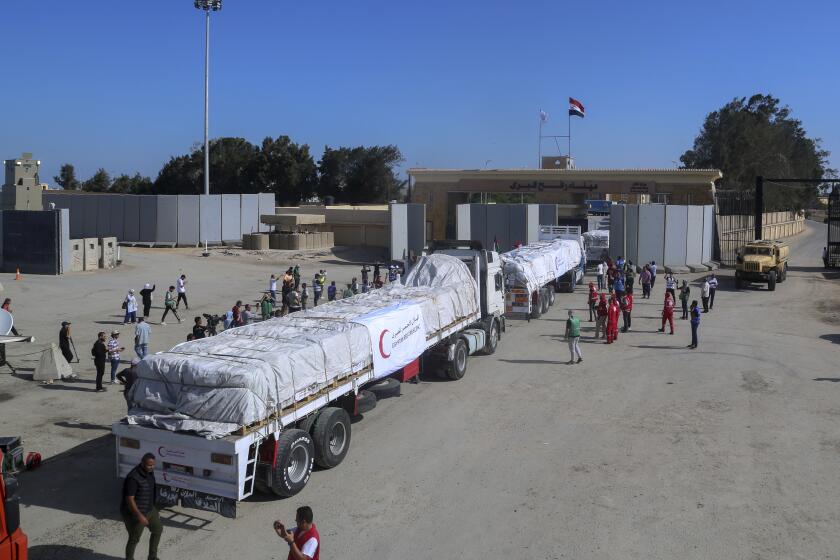How to break the cycle of aiding Gaza only to see it destroyed again

- Share via
I arrived in Palestine and Israel just months after Hamas’ election victory. It was July 2006, and Israel’s first Gaza war (with Hamas) and second Lebanon war (with Hezbollah) were just finishing. My wife and I were living in East Jerusalem, where our two kids would learn to walk and over the years form indelible memories in Israel and the occupied West Bank.
The 2006 election, in which just 191,000 Gazans (8.3% of today’s population) cast a ballot in favor of Hamas, is often touted as proof that Gaza’s population supports terrorism. Lesser known is that exit polling showed that 83% of voters in the Gaza Strip, the West Bank and East Jerusalem supported peace with Israel, and 75% believed Hamas should change its policy toward Israel. Hardly a vote for radical ideology.
The current truce is an important step. But the U.S. government should join in global calls for a cease-fire in Gaza.
As humanitarian workers, we witnessed Israel’s imposition of a complete blockade of Gaza, preventing the free flow of goods and people between the tiny coastal enclave and the outside world. Because of the lack of raw materials and no access to markets beyond its borders, productive industries collapsed and unemployment soared, forcing the population into near-total aid dependency.
Shocked by the election results, the U.S. and Europe followed Israel’s lead in boycotting any engagement with a Palestinian Authority that had Hamas in its coalition (2006-07). Seeking to maintain momentum toward building a Palestinian state as part of a two-state solution, the U.S. established a framework for provision of aid through Palestinian civil society organizations, outside the control of the Palestinian Authority, which governs parts of the occupied West Bank. Since 2007, after the collapse of the governing coalition and the Hamas takeover of Gaza, the U.S. has employed that framework in the Strip ever since.
Of the nearly 7,000 Palestinians held by Israel, the majority have never been convicted of a crime, including more than 2,000 held in administrative detention, in which the Israeli military can hold a person without charge or trial.
Looking back now, we can see how humanitarian aid, as well-intentioned as it seemed, served as a wedge against Hamas, and ironically enabled Israel to shirk its obligations under international humanitarian law to provide for the needs of the occupied population.
Nongovernmental organizations like mine, rushed into the political vacuum to buffer Gaza’s civilians from the economic repercussions of Israel’s siege. In late 2006, our first humanitarian projects offered cash for work to help keep families afloat. With limited materials, Gazan work crews were often tasked with cleaning public spaces using brooms to push litter into piles along the curb. With no functioning municipal services to collect the piles, wind would scatter them overnight, for workers to repeat the task the following day. If our programs were Sisyphean, at least they provided reliable cash in pockets. Workers could collect $250 for 20 days of work, allowing their families to subsist just above the 2006 poverty line.
The Hamas attack represented a spectacular failure of Israel’s ‘mowing the grass’ strategy in the Gaza Strip. Only better conditions can break the cycle.
Over the years, our humanitarian initiatives became more innovative. We built a water desalination system for 50,000 residents, and we helped thousands of youth to develop leadership and community engagement expertise, learn coding and design and gain essential skills to build their careers as remote workers in the global technology economy. Hamas authorities were not supportive and their security officials harassed, intimidated and even detained our staff and program participants to stifle these programs. Stringent “no-contact” policies from our international funders prohibiting engagement with Hamas authorities left few options for us to protect our people beyond trying to operate under the radar.
Cross-border violence every few years also spiked into more significant conflicts which disproportionately harmed Gazans. For example, in 2008-09, 1,385 Gazans and four Israelis were killed; and in 2014, 2,251 Gazans and 39 Israelis were killed. Israel vowed in each of these wars to eliminate Hamas’ military capacity, and each time, despite Israel’s vast military advantage, they failed.
One big obstacle is that Israeli bombs are still raining down on Gaza. Another is that Israel is wary of inadvertently fueling Hamas.
Each time Gaza’s civilians suffered brutal loss of life, property, livelihoods and mass traumatization. And each time the international humanitarian community was called on to pick up the pieces. Israel, which under international humanitarian law should provide for the well-being and protection of people in the territories it occupies, instead consistently imposed enigmatic systems severely limiting humanitarian access and inhibiting reconstruction efforts.
It was so difficult to secure construction materials through legitimate means that Hamas was able to build a thriving black market economy for importation of goods through tunnels, which were run in plain sight, from Egypt. Hamas leaders not only got fabulously rich but were able to build up a vast arsenal of weaponry as well. Israel did little to curtail this, while insisting its blockade of the Strip was working to ensure their security.
The Oct. 7 atrocities are just the latest proof that Israel’s Gaza strategy of blockade and “mowing the grass” has failed horribly. Many fear Israel’s strategy was actually serving ulterior motives: the ethnic cleansing of the land between the river and the sea of its Palestinian population.
It’s not hard to see why. In Israel’s latest war on Gaza, 15,000 Gazans have been killed, more than 40% of whom are children. The scale of destruction of property and infrastructure is unprecedented, causing doubts there will be anything to go back home to when the conflict finally ends.
Not only has the U.S. bankrolled Israel’s warmaking, but based on the decades-long precedent of the international community subsidizing the cost of Israel’s occupation, Israel will no doubt expect the United States and international community to shoulder the cost of post-war humanitarian assistance and reconstruction of Gaza as well.
Extremist groups in both Israel and Palestine will continue to undermine any prospects for peace. We can no longer wait for dysfunctional governments and bad actors to negotiate in good faith. Western officials have long insisted that we shouldn’t meddle in the internal affairs of Israel and the Palestinians. But given the vast investments made over generations, and those that will be required next — to just stabilize the region — these can no longer be considered “internal” affairs.
After this war, there can be no going back to the old models. Post war, the international community must be fully empowered with unfettered access and ability to operate freely in leading the recovery and rebuilding of lives.
President Biden’s first steps in this new reality should be to completely change course. He must condition future aid on Israel ending its siege of Gaza and military occupation of the West Bank. A brighter future for both Israelis and Palestinians must be rooted in safety, dignity and human rights for all people, and there can be no progress toward these ideals in the context of military occupation. This moment has created an opening to break from this brutal cycle of violence. We must only be brave enough to seize this opportunity to bring about a radical change of direction.
Andy Dwonch is a 20-year veteran of the international humanitarian aid industry. From 2006 to 2010 and then from 2015 to 2019, he lived in Jerusalem and directed humanitarian efforts in the occupied Palestinian territories for Mercy Corps, a global humanitarian organization. @dwonch
More to Read
A cure for the common opinion
Get thought-provoking perspectives with our weekly newsletter.
You may occasionally receive promotional content from the Los Angeles Times.













